Back to article listing

Back to article listing |
 |
Shortcut to the SSP models |
| Buzzoni, A.: "Late stages of stellar evolution and their impact on spectrophotometric properties of galaxies",
2007, an invited contribution to the intl. conference "From Stars to Galaxies:
Building the pieces to build up the Universe"
(Venezia, Italy, 16-20/Oct/2006), ASP Conf. Series, no. 374, eds. A. Vallenari, R. Tantalo, L. Portinari and A. Moretti
(ASP: San Francisco), p. 311 |
| Related info to this project can also be found at the local link 1, link 2, and link 3. | ||
|
| Summary: |
The connection between AGB evolution of stellar populations and infrared vs.
ultraviolet properties of the parent galaxies is reviewed relying on the
updated lookout provided by population-synthesis theory. In particular,
planetary-nebula events and hot horizontal-branch evolution are assessed in
a unitary view to outline a plain general picture of galaxy spectrophotometric
evolution. This will include a brief discussion of relevant phenomena such as
the "UV upturn" in ellipticals and the stellar mass loss properties along
the galaxy morphological sequence.
|
A detailed and physically self-consistent modelling of post Main Sequence (MS)
stellar evolution has been a challenging effort of theoretical astrophysics since the
decade of the sixties (see, e.g., Iben 1967 and references therein for a documental
overview of the relevant pioneering works since then). One main issue in this regard is that post-MS
lifetime of stars (at every mass range) is no longer governed by the nuclear timescale
alone, but different mechanisms intervene to strongly affect stellar structure,
acting from "inside out" (e.g. convection) and from "outside in" (e.g. mass
loss by stellar wind).
This forcedly restrains any theoretical output to a preliminary empirical validation process
by matching real observations of nearby resolved stellar systems in order to suitably tune
up the wide range of free parameters potentially allowed by theory.(*)
Any successful approach in this sense, however, suffers from evident limitations
as far as distant (unresolved) galaxies are taken into account in our analysis.
By surveying different cosmic epochs and environment conditions, in fact, one might
need to leave apart the local interpretative framework, typically constrained by
the observation of low-mass metal-poor stars.
To overcome this potentially shifty bias in the analysis of deep cosmological data, and
considering that post-MS stars alone provide typically over 2/3 of galaxy total luminosity
in bolometric (Buzzoni 1995, 2005),
it is of paramount importance to assess on a more
firm basis the leading phenomena that constrain stellar evolution along its latest stages, like
the horizontal (HB) and the asymptotic (AGB) giant branches, among galaxies of different
morphological type.
(*) The study of Galactic globular cluster c-m diagrams is an illuminating example in this sense (e.g. Renzini & Fusi Pecci 1988; Chiosi et al. 1992).
|
The so-called "UV-upturn", that is the rising ultraviolet emission shortward of 2000 Å,
sometimes featuring the
spectral energy distribution (SED) of elliptical galaxies and the bulges of spirals
(Code & Welch 1979) has been for long a puzzling problem for such old galaxy environments
dominated by stars of mass comparable to the Sun.
In fact, the implied existence of an important contribution of (long-lived)
O-B stars, hotter than 30,000 - 40,000 K and providing in the most striking cases
about 2% of the galaxy bolometric luminosity (see Fig. 1), has been sometimes
identified with binaries, blue stragglers, blue HB stars, AGB manqué stars, and
post-AGB nuclei of planetary nebulae (PNe) (see Yi & Yoon 2004, for an updated review on this
subject).
Spectroscopy (Brown et al. 1997) and imaging (Brown et al. 2000) of resolved c-m diagrams for
stellar populations in local galaxies, like M32, have definitely established that this UV excess
mostly arises from the hot tail of a broad temperature distribution of HB stars further
complemented, to a lesser extent, by a PN contribution.
As a blue HB morphology is more comfortably produced
in old metal-poor globular clusters (Rood 1973) then, on this line, one
should admit that UV stars in ellipticals represent the Z « Zsun tail of an
ostensibly broad metallicity distribution peaked at much higher values, around the solar
abundance.(*)
(*) - A metal-rich chemical composition should be advocated for the star bulk in ellipticals given, for instance, a much stronger integrated Mg2 Lick index for these galaxies, compared to Galactic globular clusters (see Fig. 2, and an extensive discussion in O'Connell 1999).
|
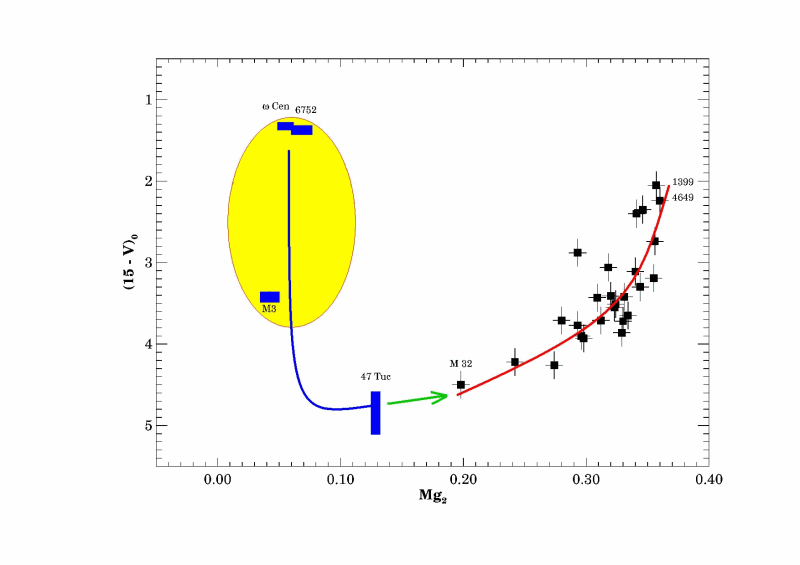 (click on the figures to enlarge) Figure 2 -
An illustrative sketch comparing UV-to-optical emission of Galactic globular
clusters (vertical ellipse to the left) and elliptical galaxies (square-marker sequence
to the right of the plot) after O'Connell 1999). The UV color is defined as
(15-V) = -2.5 log [F(1500Å)/F(V)]. Some relevant objects are labelled
for both groups.
The Mg2 Lick index is taken as standard metallicity indicator on the x-axis.
It is evident that UV-enhanced integrated colors can be reached at the two extremes of the
metallicity scale, in case of a blue HB morphology for metal-poorer globulars and due to
EHB stellar contribution in case of the most metal-rich (giant) ellipticals. See text for
discussion.
|
On the other hand, hot metal-rich HB stars might also be naturally predicted providing
stars to approach the HB phase with a conveniently low external envelope, compared
to their inner Helium core mass (Dorman et al. 1993; D'Cruz et al. 1996).
Figure 3 is an illustrative example in this sense, displaying a full set of
HB models of solar metallicity (i.e. red, intermediate and very blue stars) and their
involved post-HB evolutionary paths, based on the Dorman et al. (1993) work. So-called "Extreme HB"
stars (EHB), to be associated with hot SdO/SdB spectral types, have
actually been observed, for example in ω Cen (D'Cruz et al. 2000) and in some old Galactic
open clusters as well, like NGC 6791 (Kaluzny & Udalski 1992; Buson et al. 2006).
|
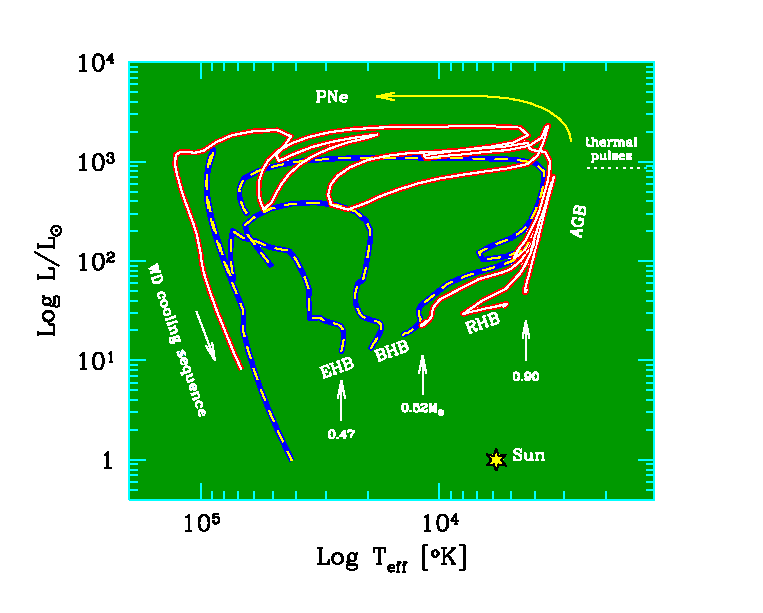 (click on the figures to enlarge) Figure 3 -
A selected set of HB evolutionary tracks with Z = Zsun from Dorman et al. (1993).
The starting track envelope roughly identify the HB locus with the value of three relevant
stellar masses (namely 0.47, 0.52 and 0.90 Msun) labelled on the plot.
Note the increasingly hotter HB temperature with decreasing stellar mass, with stars
below ~0.50 Msun occupying the EHB region of the diagram, pertinent to SdO/SdB spectral
types, fully escaping the AGB phase (these are the so-called "AGB-manqué" stars)
and directly fading along the white-dwarf (WD) cooling sequence.
The reported value of ~0.52 Msun) is the threshold for post-HB stars to end up as PNe
after completing AGB evolution and undergoing the thermal pulsing phase.
The position of the Sun on the plot is located as a general reference for the reader.
|
|
Though supplying a straightforward evolutionary framework for UV-en -hanced elliptical galaxies,
this hypothesis implies a quite delicate tuning of core mass size at the HB onset
(as a result of RGB nuclear burning processes) and mass loss efficiency (to suitably "peel off",
at the same time, stellar envelope). As a consequence, one has to expect the UV-to-optical color to
be a quite fragile and quickly evolving feature in the SED of elliptical galaxies (Park & Lee 1997).
This is confirmed in Fig. 4, where we track back-in-time evolution of a 15 Gyr simple
stellar population (SSP) of solar metallicity and intermediate HB morphology
(such as to closely resemble the temperature distribution of stars in the M3 globular
cluster), according to Buzzoni (1989) population synthesis code.
Due to the presence of stars of increasingly higher mass at early epochs (giving rise to a red
HB), one sees from the figure that the full UV burst event quickly recovers in about 3 Gyr, that
is barely a ~20% of galaxy's entire life. The UV-upturn can therefore fade by several magnitudes
as the lookback time increases by a few Gyrs, making the effect in principle detectable at
intermediate redshift (z = 0.2-0.3) (Brown et al. 2003; see also Ree et al., this conference).
|
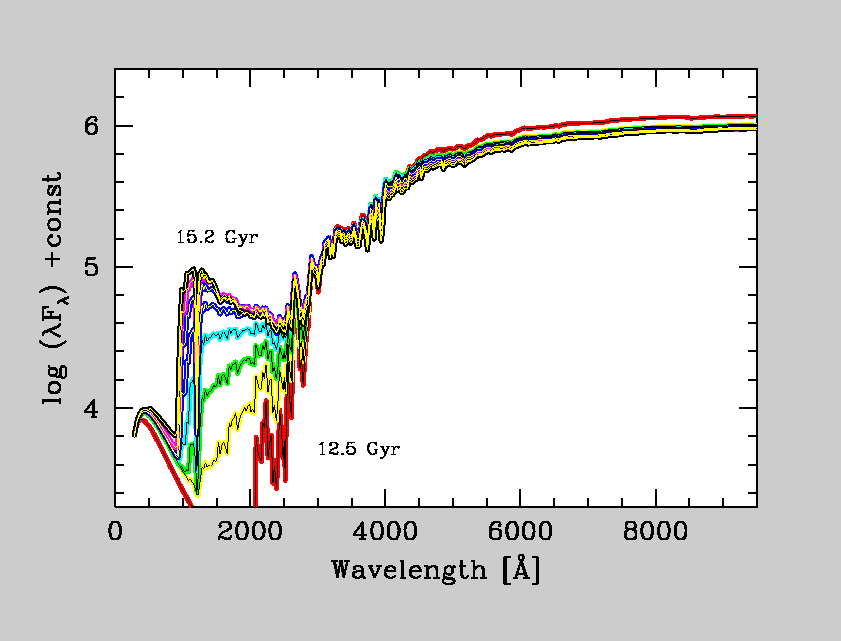 (click on the figures to enlarge) Figure 4 -
Integrated SED for a SSP of solar metallicity, Salpeter IMF and citet{reimers} mass-loss
parameter η = 0.5 after Buzzoni (1989). Spectral evolution is computed at steps of 200 Myr
from t = 15.2 to 14 Gyr, plus a further model at 12.5 Gyr, as labelled on the plot.
A broad temperature distribution of HB stars (matching the observed M3 HB morphology) is assumed at
t = 15.0 Gyr. Note the quick evolution of the UV excess between 1000 and 2500 Å,
that already disappeared in the 12.5 Gyr model in consequence of the corresponding reddening of the
HB color distribution. A second and nearly steady minor UV bump can be recognized
shortward of 1000 Å due to the contribution of PN nuclei.
|
|
Along the SSP evolution, a substantial fraction (up
to 50%) of star mass can be lost during the AGB phase via stellar wind.
If the mass-loss process is strong enough, low-mass stars entering the AGB phase can easily
approach a critical C-O core mass threshold about Mcore ~ 0.52 Msun.
This is the minimum mass
for stars to fully complete AGB evolution and experience the so-called
"thermal-pulsing" phase (Dorman et al. 1993; Blöcker 1995, see also Fig. 3 above).
Along thermal pulses, stars venture in the region of Mira variables and end up
through the so-called "superwind phase" by quickly ejecting their residual envelope and
originate a PN (see Iben & Renzini 1983, for an exhaustive discussion of the process and its
variants.
Models indicate that the lack of a full AGB deployment
(when Mcore ≤ 0.52 Msun) leads to a range of post-HB evolutionary
paths (see, again, the sketch in Fig. 3),(*)
as discussed in detail by Greggio & Renzini (1990).
One relevant case in this regard is that of EHB objects, that evolve as
"AGB-manqué" stars, thus fully escaping the PN ejection and fading directly along
the high-temperature white-dwarf cooling sequence (Castellani et al. 1992, 1995; Dorman et al. 1993;
D'Cruz et al. 1996; Yi et al. 1998).
Quite interestingly, therefore, the successful detection of PNe, even in distant unresolved galaxies,
places a further interesting constraint to the final mass of the composing stellar population.
More specifically, the PN number density per unit galaxy luminosity, a parameter
often referred to in the literature as the "α ratio" (Jacoby 1980), can directly
be linked to the characteristic lifetime of the nebulae, the latter closely tracing the
mass distribution of their nuclei (see Buzzoni et al. 2006 for a full discussion).
On the basis of these arguments, PNe can eventually help constraining the initial-to-final
mass relation (IFMR) also in extragalactic systems.
For our galaxy, the IFMR can be derived empirically from the observation of the
white dwarfs in nearby open clusters (like Hyades or Praesepe) of known age
(as obtained, for instance by the isochrone fitting method of the cluster c-m diagram).
In an exhaustive study of the available observed database, Weidemann (2000) found evidence
that white-dwarf masses, for low- and intermediate-mass
stars, closely match the theoretical core masses expected at the beginning of the thermal-pulsing AGB.
This claim is accounted for in Fig. 5, where we compare the Weidemann (2000)
IFMR with the Wagenhuber & Weiss (1994) updated set of AGB stellar tracks for Pop I stars, and with the
original analytical relation for thermal-pulsing core mass for intermediate-mass stars by
Iben & Renzini (1983).
It is clear from Fig. 5 that, for a standard range of the Reimers (1975) mass-loss
parameters pertinent to Galactic globular clusters (namely η~0.4 ±0.1, according
to Fusi Pecci & Renzini 1976) the Iben & Renzini (1983) theoretical IFMR predicts unreliably
high final masses for young (t ≤2 Gyr) SSPs, requiring a value of η » 1
to match the Weidemann (2000) empirical relation.
(*) From the physical point of view, this would correspond to the He+H double-shell burning regime for low- and intermediate-mass stars. |
|
|
As far as external galaxies are concerned, the Local Group represents a natural benchmark
to assess the IFMR through the estimated α ratio from deep PN surveys.
Quite surprisingly, in spite of the extreme variety of star formation histories among local
galaxies, Buzzoni et al. (2006) have demonstrated that observations
support a fairly constant
value of α, with an average PN rate per unit galaxy luminosity between 1 and 6 PNe per
107 Lsun among systems representative of the whole late-type Hubble
morphological sequence. Such a value is related to a quite narrow range of final stellar masses
about 0.60-0.65 Msun.
Even in case of Local Group member galaxies, therefore, the mass-loss scenario supported by
the PN observations better agrees with the Weidemann (2000) IFMR, which implies a substantially
stronger mass loss for intermediate and high-mass stars compared to the standard scenario
for Pop II stars as in Galactic globular clusters.
|
|
One important consequence of the "AGB-manqué" evolution of EHB stars
is that a tight and inverse relationship must be in place, especially involving
elliptical galaxies, between the most PN-poor and UV-enhanced stellar systems.
A prevailing fraction of hot (low-mass) HB stars in the galaxy stellar population, in fact, can
be strongly favoured by a more efficient mass loss (at least along the RGB evolution),
and this scenario, by itself, also plays against any full AGB deployment.
Therefore, if this is the case, few stars (if any) can eventually reach the AGB feeding
the PN production channel.
As shown in Fig. 6 (left panel) this correlation is actually displayed between
PN luminosity-specific rate α and the (1550-V) color for elliptical galaxies in
the Virgo and Fornax clusters, and in the Leo group, after Buzzoni et al. (2006).
The sense is that
more massive metal-rich systems (traced by a higher velocity dispersion σv and
a stronger integrated Lick Mg2 index) display at a time a stronger UV-upturn
and a poorer PN population per unit galaxy luminosity.
The Buzzoni et al. (2006) relationship settles an old (and so
far unexplained) empirical evidence
for a trend of PN rate, seen to decrease among the reddest ellipticals (Hui et al. 1993).
As α can actually be considered as an indirect probe of galaxy AGB extension above the
thermal-pulses threshold, this would naturally lead to expect some correlation between the PN
luminosity-specific rate and galaxy infrared colors or, even better, with more sensitive
and unbiased tracers of the cool galaxy stellar component. This is, for instance, the case of the
infrared effective magnitudes, as derived from the surface-brightness fluctuation method of
Tonry & Schneider (1988).
Again, our guess is fully confirmed by a study of the Virgo and Leo elliptical sample
(Buzzoni & González-Lópezlira, in preparation), as shown in the right panel of
Fig. 6 based on Cantiello et al. (2003) compilation database.
|
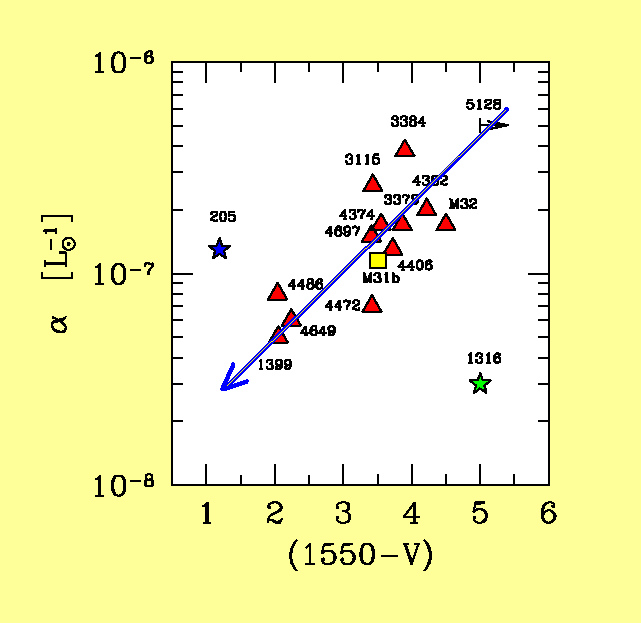
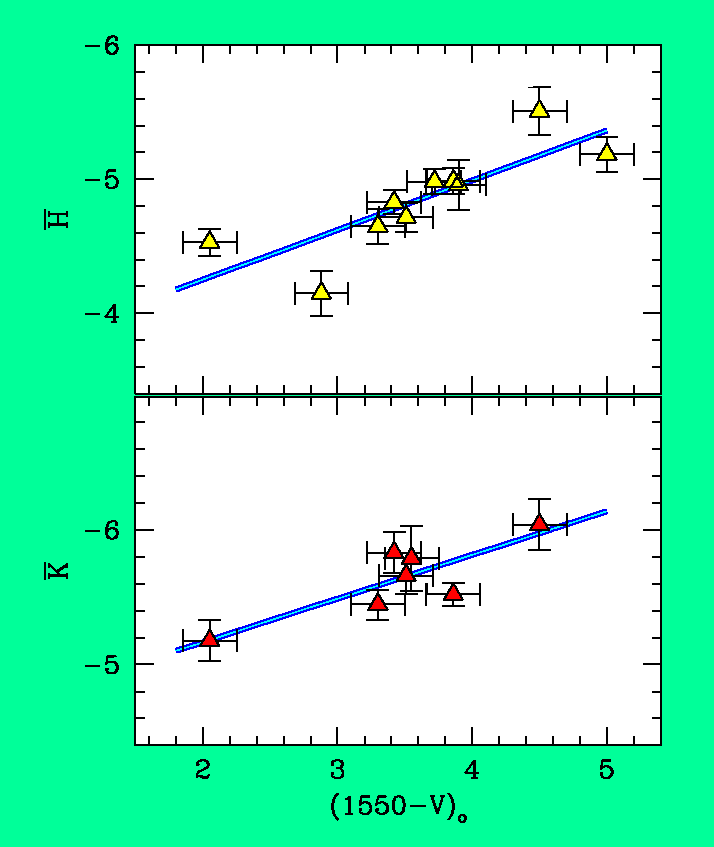 (click on the figures to enlarge) Figure 6 -
Left panel: the observed relationship between PN luminosity-specific rate
α and integrated ultraviolet-to-optical emission (as defined in Fig. 2)
for a sample of elliptical galaxies in the Local Group and in the Virgo, Leo and Fornax
clusters according to Buzzoni et al. (2006). The relevant case of outliers like NGC205 (star-forming)
and NGC1316 (merger elliptical) are singled out in the plot. Right panel: the corresponding
relationship in place among the Cantiello et al. (2003) sample of quiescent ellipticals vs.
Tonry & Schneider (1988) effective magnitudes in the H and K infared bands.
The most UV-enhanced galaxies display the faintest infrared effective magnitudes,
sensitive of a less deployed AGB. |
|
Blöcker, T. 1995, Astron. Astrophys., 299, 753 |
Back to article listing |
 |
Shortcut to the SSP models |
| AB/Apr 2007 |